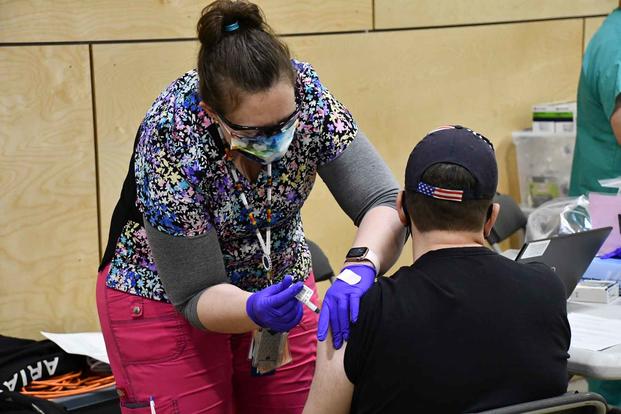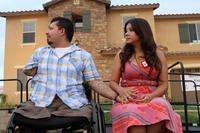Steven L. Lieberman, M.D., leads the Veterans Health Administration, the largest integrated health system in the nation, managing a budget of more than $87 billion and overseeing the care of 9 million veterans. He is a board-certified physician in pulmonary and critical care and has over 25 years of experience with the VA.
Carolyn Clancy, M.D., leads VHA's missions in health professions training, research and health care innovations. A graduate of Boston College and the University of Massachusetts Chan Medical School she is also an elected member of the National Academy of Medicine and has been frequently included in Modern Healthcare's top clinical executives and top 100 for health care.
The opinions expressed in this op-ed are those of the author and do not necessarily reflect the views of Military.com. If you would like to submit your own commentary, please send your article to opinions@military.com for consideration.
The U.S. lost its first veteran to COVID-19 on March 4, 2020, followed by a devastating two years for those mourning loved ones.
More than 21,000 American families have lost a veteran to COVID-19 and about 250 Department of Veterans Affairs employees have passed away -- making for extremely difficult times for us all.
Looking back on two years of loss and hardship, we believe it is important to acknowledge the accomplishments during such an unprecedented time. As the nation's largest health care system, we fought around the clock to battle this terrible virus. This required teamwork, agility and planning on a unique scale. We could not be prouder of our VA teammates for their hard work, passion and dedication in responding to this difficult and often heartbreaking global crisis.
As we continue to recover and rebuild from the COVID-19 pandemic, it is vital we are prepared for future crises.
The pandemic has demonstrated the power of real-time data and information sharing between health care institutions, public health organizations and policymakers. We built these data and information-sharing processes for regional emergencies such as hurricane recovery, and we must do the same for national emergencies that require a health care response.
To do so, all parties need to build on the foundation we created -- an imperative to commit to further collaboration that links capabilities and connects data systems. By sharing our discoveries and innovations, we can improve care and resources for everyone across our country.
Capacity
Health care is fundamentally a human endeavor. It can benefit from science and technology, but it still requires teams of individuals to provide customized care for each patient. In practical terms, this means that seriously ill patients require more staff, space and resources to care for them.
In the case of COVID-19, one of the largest issues we faced stemmed from the prevalence of severe lung infections, requiring acute and critical care over extended periods of time and driving up the need to expand inpatient capacity in communities experiencing surges. Early on, we recognized this kind of inpatient care would become one of the greatest health care challenges of the pandemic.
Meeting surges in demand for both acute care and critical care required finding the space and staff to care for seriously ill patients in creative ways. The VA's unique position as a nationwide health care system allowed us to pivot quickly to find medical-surgical and intensive-care unit beds for COVID-19 patients, along with health care workers to staff those beds.
Over the course of the pandemic, the VA added 3,000 beds to its national inpatient capacity by converting unused space or upgrading under-used space into acute care and critical care rooms. At the request of more than 40 state governors, we expanded bed capacity for non-veteran patients at VA facilities in communities where the hospitals were challenged by surging hospitalizations from COVID-19. We were proud to care for our neighbors, friends and family members alongside many other federal agencies when asked.
As the need for beds skyrocketed, staffing shortages inevitably rose. An overwhelming need for staff coincided with intense demands on health care personnel, but the VA's ability to deploy nurses, physicians and other health care staff allowed hospitals across the country to continue to provide their best treatment. More than 5,000 clinical staff did not hesitate to deploy to overloaded VA and community hospitals, tribal health systems, state veterans homes, community nursing homes and community vaccination campaigns. Our personnel are our greatest asset, and we are honored that we were able to provide so much support to our nation in this time of great difficulty.
As we move forward, the VA believes one area that needs further development is our nation's ability to pivot rapidly alongside the changing nature of viruses. ICU beds were of greatest need to combat the original strain of COVID-19, as well as the Alpha and Delta variants, but medical-surgical beds were in highest demand for Omicron. Data collection and careful monitoring have helped us adjust to this changing need.
Research
Battling a pandemic requires both expanded capacity for care and urgent acquisition of knowledge about the disease, and the health care community needed to conduct research right alongside the fight against COVID-19. Our considerable research capability across the VA, conducted in association with major pharmaceutical companies, other private institutions and government agencies, has allowed us to work quickly to adjust to the changing nature of this virus, all under the banner of a single mindset: innovation.
In the last two years, we have launched approximately 400 COVID-19 studies and published more than 100 articles on the disease and its effects. More than 57,000 veterans have volunteered to take part in clinical trials related to COVID-19 treatment and prevention, including trials for all three vaccines currently available in the U.S. We continue to operate a database of resources that are shared broadly to promote scientific innovation and discovery.
The path to this point has been difficult and we have lost too many lives, but we are grateful for the people we were able to help. Since the start of the pandemic, we are proud to report we have vaccinated more than 4 million veterans, more than 320,000 VA employees and nearly 145,000 additional people throughout the country.
Right now, there are birthdays being celebrated that might have been missed. Grandchildren are listening to stories told to them by their grandparents. Families and friends are enjoying more time together. We are grateful to be part of their stories.
Our care system has been learning, growing and adapting for 75 years. Never have we been tested as we are by the COVID-19 pandemic. Through determination, dedication and teamwork, we have fought this disease together.
Go here to learn more about VA's work on the Fourth Mission -- to assist the nation in times of emergencies, and here to learn more about VA's COVID-19 response.















